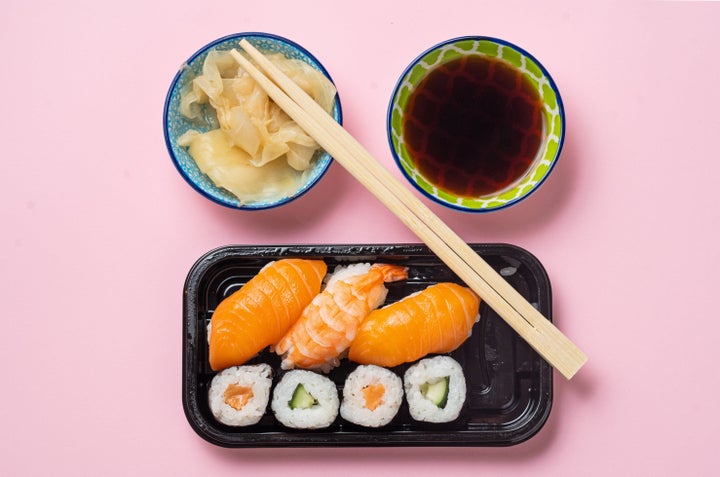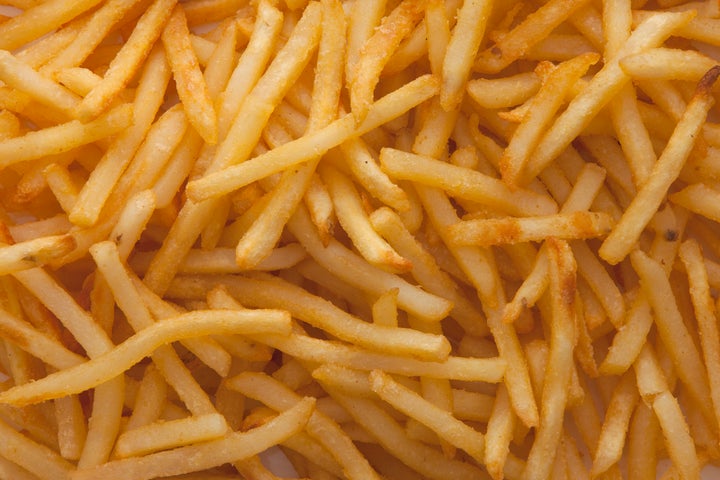
When you’re looking to expand your go-to roster of delivery eats beyond pizza and Chinese food (the no-fail legends of takeout), the process can be more challenging than meets the eye. Just because popular restaurant meals are available for delivery doesn’t mean they’ll successfully handle the journey.
“Sauces split, crusts get soft and melty cheeses turn to rubber,” said Shawn Matijevich, a lead chef of online culinary arts and food operations at the Institute of Culinary Education. “Some favourite preparations are really time-sensitive, with soup being at one end of the spectrum and soufflé at the other.”
So, which delivery options are least likely to lose their lustre by the time they reach your door? And which should be ordered with caution, if at all? Here’s what chefs had to say.
Best: Soups, Stews
The main qualities that keep soups and stews in tip-top shape from a chef’s kitchen to your door is their consistency and how well they hold heat.
“Soups and stews are moist heat preparations, characterised by the presence of moisture during the cooking process,” Matijevich said. Once packaged for delivery, “any steam that rises from the soup or stew will condense, turning from a gaseous state to a liquid state as it loses heat energy.”
As the steam cools, it forms droplets that fall back down into your takeout bowl.
“This process is cyclical and won’t negatively affect the flavour or structure of the soup or stew,” Matijevich said.
It also reheats easily, so even if your order does cool on the way from the restaurant, neither its appearance nor the quality of taste will decline if you pop it in the microwave or a saucepan.
Worst: Fresh Pasta
Once your pasta’s been doused in sauce and popped into a takeout container, the pasta will continue to cook and soak up the sauce, morphing what would be a delish dinner into a congealed glob.
“Anything cream- or egg sauce-based will be especially difficult,” said Patricia Clark, owner and executive chef of All Five Senses private chef services. “Steam will separate the sauce and any temperature variations will make it coagulate to only parts of the dish.”
The fix: If you can’t help but cave to your pasta cravings, have the restaurant deliver your order with the ingredients disassembled in separate containers, Clark said. For example, your linguine may be precooked to al dente and sent with separate containers of lemon cream sauce, and shredded parmesan and lemon zest.
Best: Casserole-Style Dishes
Meals that are baked in the oven casserole-style, such as lasagna, enchiladas, and mac and cheese, work well as a delivery option because the sauces tend to be thicker.
“Noodles sitting in liquid tend to get soggy, but because many casserole dishes are meat- and cheese-based, they hold up better,” said Traci Weintraub, the founder and head chef of the food delivery service Gracefully Fed.
Shepherd’s pie and moussaka are also excellent contenders. Since the mashed potatoes featured in both dishes are dense, they can absorb some liquid (take that, condensation!) and help insulate, which keeps texture changes to a minimum.
Worst: Steak, Grilled Meat
The main problem with getting a steak or other grilled meat delivered is it’s very difficult for it to arrive at the level of doneness you prefer.
“If a steak is taken off the grill and packaged immediately, it will continue to cook on the way to you,” Weintraub said. “This often results in overcooked meat.”
The fix: To maximise the quality of your order, it’s best if the meats are cooked to a temperature below your preference, not sliced, with sauces on the side.
Once delivered, bust out your skillet and heat a teaspoon of olive oil over medium-low heat. Add your meat, then flip every minute until your desired doneness has been reached and slice away.
If receiving your meat ready-to-go is a must, you can “ask to have it sliced, half-cooled and wrapped in foil, with any sauces kept on the side,” Clark said. Your order won’t get to you piping hot, but the odds of your meat being overcooked by the time it hits your doorstep will be minimised.
Best: Pulled Pork
The hot, moist environment of a to-go container doesn’t affect pulled pork in a negative way, Matijevich said, so no need to worry about the meat drying out or ending up rubbery. Plus, anything already coated in sauce is going to reheat well. (Just make sure your go-to fixins — toasted bun, coleslaw — are packaged separately to avoid a potentially soggy situation.)
Worst: Dressed Salads
When you order a salad and it’s dressed at the restaurant, it’s likely to be soggy — and sometimes warm, depending on the toppings — by the time it’s dropped off to you, Weintraub said.
The fix: Salads can travel well, but only if you ask for the dressing on the side. Meat-centric toppings and warm dressings should also be packed separately, so your lettuce doesn’t become droopy. You can then reheat what should be warm before mixing your salad together.
If you love some crunch, either ask to have your croutons packed separately to ensure they stay that way or swap them out for crispy chickpeas, which usually hold up better during travel, Weintraub said.
Best: Soft Tacos
“Tacos are often made with toppings and sauces presented on the side for easy assembly at home,” Matijevich said. But even if you prefer yours already assembled, they still hold up surprisingly well.
Soft corn or flour tortillas work best for delivery, Weintraub said, as any liquid (steam, moisture) from your go-to toppings are liable to make the bottom of a hard shell lose its crunch. To keep sogginess to a minimum, have toppings like guac and salsa packaged on the side.

Worst: Fried Or Breaded Foods (Looking at you, French fries)
Fried and breaded foods tend not to hold up well during delivery.
“Hot foods emit moisture after cooking,” Weintraub said. “When they’re put in a travel container, the steam accumulates, causing fried and breaded foods to lose their crispy texture and become soggy.”
The fix: Your best bet for reheating fried or breaded foods is in the oven or an air fryer, Weintraub said, adding: “A microwave oven is likely to compound the moisture collection and leave them even soggier.”
Using a wire rack on top of a sheet pan, place the food in an even layer across the rack and pop it under a preheated broiler. The time it takes to crisp up will vary depending on the food itself, so keep a close eye on it, turning the food once it’s sizzling and removing it once the other side is done.
If busting out your air fryer, follow the manufacturer’s instructions for reheating.
Best: Indian Dishes
Because Indian dishes are typically liquid-based, they retain heat well and you don’t have to worry about them getting soggy, Weintraub said. They also tend to be accompanied by rice and beans, two staples that travel well, thanks to the level of moisture they contain.
Bonus: Similar to soups and stews, reheating won’t affect textures or flavours. (To ensure your rice doesn’t dry out during reheating, Weintraub recommended placing an ice cube on top.)
Worst: Cold Sandwiches
Cold sandwiches tend to involve a lot of wet ingredients and dressings, all of which can turn bread into a slimy sog-fest.
The Fix: This depends on your sandwich of choice.
“Anything mayo-bound (tuna, crab or chicken salad) should be kept separate from the bread until you’re ready to eat it,” Clark said.
Wetter sandwiches — anything with sliced tomato, cucumber, soft cheeses and the like — tend to deliver better when prepared first in a lettuce bundle, where the top and bottom layer of the sandwich consists of washed and thoroughly dried lettuce.
“The lettuce helps absorb any moisture before it hits the bread,” Clark said.
Another option is to switch things up and have Italian, French or Spanish-style sandwiches delivered instead of the usual choices.
“These tend to be better delivery options because they have little to no dressings,” Clark said. Think: French ham and gruyere or Italian salty meats (proscuitto, bresola, coppa) and roasted peppers.
Best: Hot Sandwiches
“Hot sandwiches, such as chicken parm, Philly cheesesteak and meatball subs, work best when delivered with filling separate from the base bread,” Clark said. This makes it easy to reheat your toppings should your delivery show up lukewarm, and protects your bun from turning to mush.
If having your hot sandwich arrive fully formed is a must, look into how it will be packaged before placing your order. Clark recommended it be tightly wrapped first in sandwich paper, then in foil, followed by plastic.
“The paper absorbs some of the oil, the foil keeps it hot, while the plastic acts as a second insulator (and keeps any excess sauce from spilling into the delivery bag),” Clark said.
Worst: Seafood
“In general, seafood isn’t the greatest delivery option because the texture can change fast with temperature variations,” Clark said. “The steam effect from takeout containers will not only keep it cooking, but make the texture mushy or rubbery.”
The fix: Really, the only way around this issue would be to have your seafood cooked, then fully cooled before it’s packaged for travel.
“Any sauces, garnish and sides should be kept in completely separate containers,” Clark said.
To lower the risk of your fish drying out when you reheat it at home, opt for thicker pieces of broiled, grilled or pan-seared seafood, which can be reheated quickly in the oven using the broiler setting, Clark said.
Place the fish on an aluminium foil-lined baking sheet drizzled with oil and pop it under the preheated broiler, leaving the oven door slightly ajar. The entire process shouldn’t take more than one minute, depending on the thickness of your fish. To reheat it as evenly as possible, flip the fish halfway through.
“In the case of bivalves, such as clams, scallops or mussels, it really is best that these are cooked at home,” Clark said. “They cook very quickly and can turn mushy or rubbery with prolonged steam, even if only five minutes worth.”
To save yourself the hassle yet still get your seafood fix, stick to delivery orders that involve moist heat preparations, a la curries or clam chowder.
Best: Sushi
“Sushi is meant to be served at room temperature, so it travels really well,” Matijevich said. Rolls are a better bet for delivery than nigiri, since fish balanced on top of rice is much less likely to survive the trip.
But if you do decide on sushi, make sure it’s kept completely separate from any hot food items you might be ordering.
“Steam and heat aren’t only bad for texture, but bacterial growth,” Clark said.